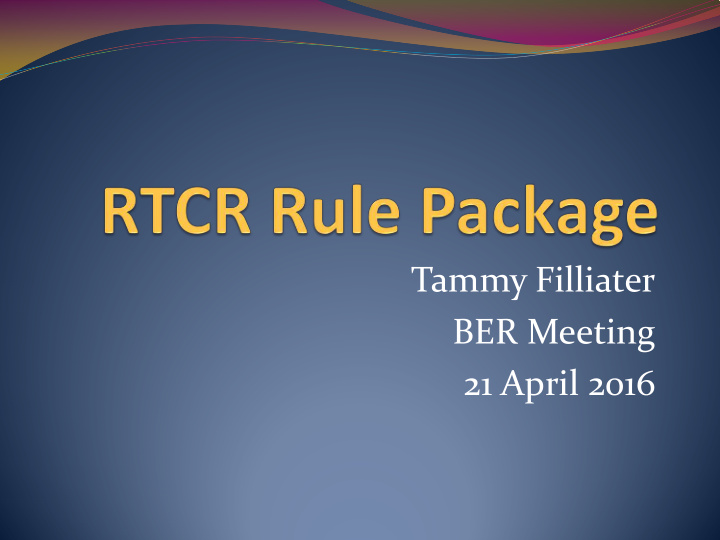



Tammy Filliater BER Meeting 21 April 2016
Projected Timeline for Rule Proposal and Adoption Scope of Rule Package Bird’s Eye View of Rule Package Questions
Projected Timeline for Rule Proposal and Adoption . . .
Feb 2013 RTCR Adopted (78 FR 10269) Feb 2013 on Outreach / PWS Focus Group Input Feb 2015 MT Requests / Receives Extension March 2016 EPA, Postcards April RTCR Implemented (EPA) June? Propose Rules Sept? Adopt Rules Feb 2017 Primary Extension Deadline
. Scope of Rule Package . .
RTCR 2015 Edition of the CFR Housekeeping and Clarifications
. . Bird’s Eye View of Rule Package .
TCR of 1989 EPA is required to review and revise each national primary drinking water regulation every 6 years SDWA requires any revision to “maintain, or provide for greater, protection of the health of persons” Applies to all public water systems
Site Sampling Plans 1. 2. Testing for E. coli 3. Seasonal Systems 4. Coliform Monitoring Frequency 5. Clean Compliance History 6. Dual Sampling 7. Temporary Routines 8. Level 1 and 2 Assessments
Total Coliforms Fecal Coliforms E. coli
Perform and Document Start-up Procedure Flushing stagnant water from pipes Inspecting equipment Checking chemicals Testing a sample of water for coliforms (state discretion)
System Type Routine Montana All PWS > 1,000 1+/month Yes Surface Water, GWUDI of Surface Water, or 1/month Yes Blended Surface Water/GWUDI ≤ 1,000 GW CWS ≤ 1,000 1/month Yes GW NCWS ≤ 1,000 1/quarter No Seasonal NCWS ≤ 1,000 1/month Yes MAR notice 17-089, published in 1999
System Type Reduced Montana GW CWS ≤ 1,000 1/quarter No No; non- seasonal GW NCWS ≤ 1,000 1/year 1/quarter Seasonal NCWS ≤ 1,000 1/quarter or No 1/year
System Type Through March 2016 Beginning April 2016 All Systems Monitor monthly. Monitor monthly. Seasonal TNC Systems, Can qualify for quarterly No longer qualify for Using only GW and monitoring by meeting quarterly monitoring. Serving 1,000 or Fewer specific requirements. People Non-Seasonal TNC Can qualify for quarterly Can qualify for quarterly Systems, Using only GW monitoring by meeting monitoring by meeting and Serving 1,000 or specific requirements. specific requirements. Fewer People
Federal Definition: a record of no MCL violations under §141.63; no monitoring violations under §141.21 or subpart Y; and no coliform treatment technique trigger exceedances or treatment technique violations under subpart Y. State Policy: A system must have satisfactory total coliform test results for 24 months and no MCL exceedances, monitoring violations, or TT violations of any kind for 12 months.
Montana, through April 2016, allowed the use of dual • samples. GW systems serving 1,000 or fewer people qualified. Example: • A routine sample comes back positive • With dual sampling, this triggers the collection of 3 • repeat samples and 1 dual sample. (4 samples)
Montana proposes to NOT adopt dual sampling. Only • systems with a single GW well serving ≤ 1,000 would be eligible. Example: • A routine sample comes back positive • Without dual sampling, this triggers the collection • of 3 repeat samples. (3 samples)
Before April 2016: • Small systems: 5 temporary routines are required the month following a positive routine followed by a positive repeat Current (with RTCR): • Small systems: a level 1 or 2 assessment is triggered following a positive routine followed by a positive repeat
Triggered by: • 1. Small systems: 2 or more TC+ routine/repeat samples in the same month. Large systems: greater than 5% of routine/repeat samples are positive. 2. Failure to take all required repeat samples after any single TC+ result.
Triggered by: • 1. E. coli MCL violation 2. A second triggered level 1 assessment within a rolling 12 month period Completed by DEQ personnel •
Recommend
More recommend